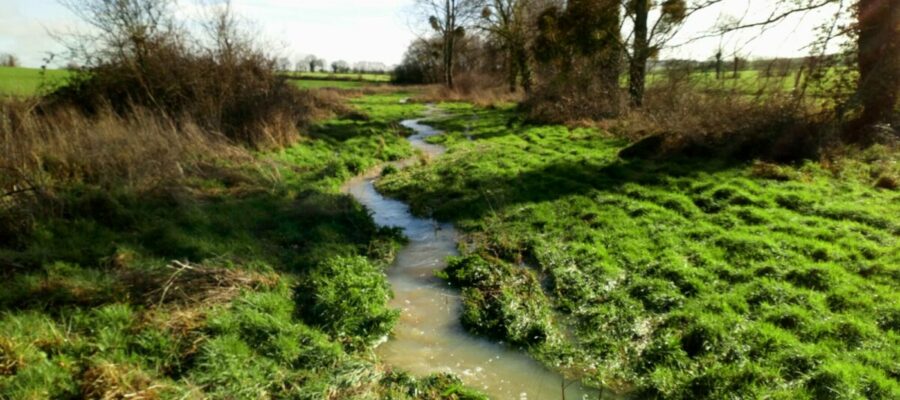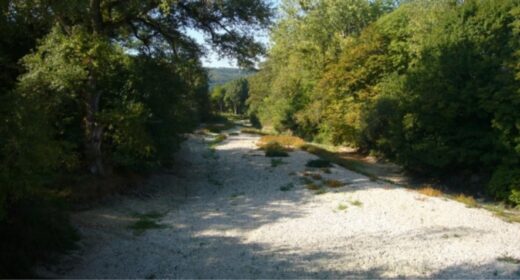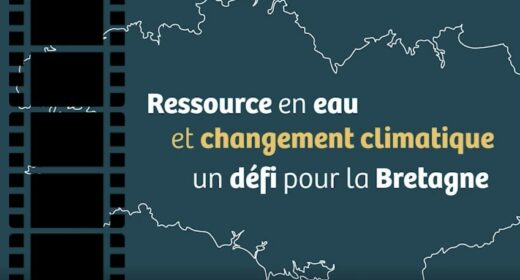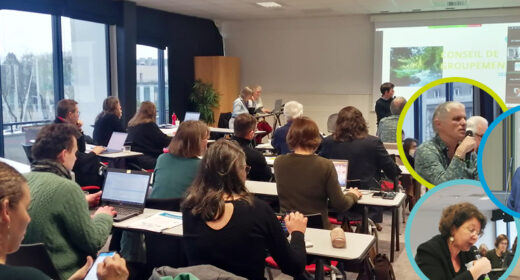La cellule ASTER d’appui technique milieux aquatiques du CD35, en lien étroit avec l’AELB et la FDPPMA35, met en place une veille scientifique sur des thématiques spécifiquement liées à la restauration hydromorphologique et biologique des cours d’eau.
Les rendez-vous Journal Club, proposés par la cellule ASTER, permettent d’exposer les résultats de cette veille à l’ensemble des techniciens milieux aquatiques d’Ille-et-Vilaine via de courts webinaires thématiques.
Lors de ces rendez-vous, les différentes thématiques auxquelles les techniciens milieux aquatiques sont confrontés lors de travaux de restauration hydromorphologique sont abordées, avec la présentation 1/de résultats issus d‘articles scientifiques récents et 2/de retours d’expériences adaptés et vérifiés sur le territoire Bretilien. Des préconisations techniques pour la restauration peuvent émerger de ces études et retours d’expériences.
Le « Journal club » propose un rendez-vous tous les trimestres aux techniciens milieux aquatiques d’Ille-et-Vilaine. Les enregistrements de ces webinaires ainsi que l’ensemble des ressources présentées sont disponibles ci-dessous.
Journal club n°1 – La forme du lit des cours d’eau en tête de bassin versant : relations entre le profil des berges et la rugosité
Ce premier webinaire a été proposé aux techniciens milieux aquatiques d’Ille-et-Vilaine le 26 mai 2021.
Vidéo et support de présentation
Références bibliographiques en lien avec le Webinaire
- DAS, V. K., ROY, S., BARMAN, K., CHAUDHURI, S., & DEBNATH, K. (2019). Study of clay–sand network structures and its effect on river bank erosion: an experimental approach. Environmental Earth Sciences, 78(20), 1-18. Lien URL
- GALINEAU, M., LE BIHAN, M., HUBERT, A. (2019). Caractérisation de stations de référence hydromorphologique sur le territoire Bretagne et Pays de la Loire. DIR AFB. Rapport de stage de fin d’études.
- GOB, F., BILODEAU, C., THOMMERET, N., BELLIARD, J., ALBERT, M. B., TAMISIER, V., … & KREUTZENBERGER, K. (2014). Un outil de caractérisation hydromorphologique des cours d’eau pour l’application de la DCE en France (CARHYCE). Géomorphologie: relief, processus, environnement, 20(1), 57-72. Lien URL
- JUEZ, C., BÜHLMANN, I., MAECHLER, G., SCHLEISS, A. J., & FRANCA, M. J. (2018). Transport of suspended sediments under the influence of bank macro‐roughness. Earth Surface Processes and Landforms, 43(1), 271-284. Lien URL
- KRISTENSEN, E. A., KRONVANG, B., WIBERG-LARSEN, P., THODSEN, H., NIELSEN, C., AMOR, E., … & BAATTRUPPEDERSEN, A. (2013). 10 years after the largest river restoration project in Northern Europe: Hydromorphological changes on multiple scales in River Skjern. Ecological engineering, 66, 141-149. Lien URL
- MUOTKA, T., & LAASONEN, P. (2002). Ecosystem recovery in restored headwater streams: the role of enhanced leaf retention. Journal of applied Ecology, 39(1), 145-156. Lien URL
- NICHOLAS, A. P. (2013). Modelling the continuum of river channel patterns. Earth Surface Processes and Landforms, 38(10), 1187-1196. Lien URL
Journal club n°2 – Etat des lieux et sensibilité écologique des rivières intermittentes
Ce second webinaire a été proposé aux techniciens milieux aquatiques d’Ille-et-Vilaine le 29 juin 2021.
Vidéo et support de présentation
Références bibliographiques en lien avec le Webinaire
- BOULTON, A. J. & JENKINS, K. M. (2007). Detecting impacts and setting restoration targets in arid‐zone rivers: aquatic micro‐invertebrate responses to reduced floodplain inundation. Journal of Applied Ecology 44 (4), 823 832. (Lien URL)
- DATRY, T., LARNED, S. T., & TOCKNER, K. (2014) 2014). Intermittent rivers : a challenge for freshwater ecology. BioScience 64 (3), 229 235. (Lien Url)
- JENKINS, K. M., & BOULTON, A. J. (2003). Connectivity in a dryland river: Short‐ term aquatic microinvertebrate recruitment following floodplain inundation. Ecology 84 (10), 2708 2723. (Lien Url)
- LAKE, P. S. (2003). Ecological effects of perturbation by drought in flowing waters. Freshwater biology 48 (7), 1161 1172. (Lien URL)
- LEIGH, C., BOULTON, A. J., COURTWRIGHT, J. L., FRITZ, K., MAY, C. L., WALKER, R. H., & DATRY, T. (2016) 2016). Ecological research and management of intermittent rivers : an historical review and future directions. Freshwater Biology 61 (8), 1181 1199 (Lien Url)
- MAS MARTÍ, E., GARCÍA BERTHOU, E., SABATER, S., TOMANOVA, S., & MUNOZ, I. (2010). Comparing fish assemblages and trophic ecology of permanent and intermittent reaches in a Mediterranean stream . In Global Change and River Ecosystems Implications for Structure, Function and Ecosystem Services (pp. 167 180). Springer, Dordrecht.(Lien URL)
- MESSAGER, M. L., LEHNER, B., COCKBURN, C., LAMOUROUX, N., PELLA, H., SNELDER, T., … & DATRY, T. (2021). Global prevalence of non perennial rivers and streams. Nature 594 (7863), 391 397. (Lien Url)
- SNELDER, T. H., DATRY, T., LAMOUROUX, N., LARNED, S. T., SAUQUET, E., PELLA, H., & CATALOGNE, C. (2013). Regionalization of patterns of flow intermittence from gauging station records. Hydrology and Earth System Sciences 17 (7), 2685 2699. (Lien Url)
Journal club n°3 – L’intérêt de restaurer la séquence “radier-mouille”
Ce troisième webinaire a été proposé aux techniciens milieux aquatiques d’Ille-et-Vilaine le 22 septembre2021.
Vidéo et support de présentation
Références bibliographiques en lien avec le Webinaire
- MERMILLOD‐BLONDIN, F., CREUZÉ DES CHÂTELLIERS, M., MARMONIER, P., & DOLE‐OLIVIER, M. J. (2000). Distribution of solutes , microbes and invertebrates in river sediments along a riffle‐pool‐riffle sequence . Freshwater biology , 44 (2), 255 269 (Lien pdf)
- MONTGOMERY, D. R., & BUFFINGTON, J. M. (1997). Channel reach morphology in mountain drainage basins. Geological Society of America Bulletin 109 (5), 596 611. (Lien pdf)
- MUOTKA, T., & LAASONEN, P. (2002). Ecosystem recovery in restored headwater streams: the role of enhanced leaf retention. Journal of applied Ecology 39 (1), 145 156. (Lien pdf)
- NAMOUR, P., ESCHBACH, D., SCHMITT, L., & BREIL, P. – Méthodologie d’identification des zones de concentration de pollution en cours d’eau péri urbain. In 7ème Colloque Interdisciplinaire en Instrumentation, Jan 2016, Saint-Nazaire, France. ffhal-01280188f (Lien pdf)
- NAVRATIL, O. (2005). Débit de pleins bords et géométrie hydraulique: une description synthétique de la morphologie des cours d’eau pour relier le bassin versant et les habitats aquatiques – Doctoral dissertation, Thèse de doctorat en mécanique des milieux géophysiques et Environnement, Institut National Polytechnique de Grenoble. (Lien pdf)
- NEWBURY, R., GABOURY, M. (1993). Exploration and rehabilitation of hydraulic habitats in streams usin principles of fluvial behaviour. Freshwater Biology, 29 : 195 210. (Lien pdf)
- OPDYKE, M. R., DAVID, M. B., & RHOADS, B. L. (2006). Influence of geomorphological variability in channel characteristics on sediment denitrification in agricultural streams. Journal of environmental quality 35 (6), 2103 2112. (Lien pdf)
- ORAISON, F., SOUCHON, Y., VAN LOOY, K. (2011). Restaurer l’hydromorphologie des cours d’eau et mieux maîtriser les nutriments: une voie commune ? Pôle Hydroécologie Cours Eau Onema Irstea Lyon MAEPLHQ. 42p. (Lien pdf)
- PECHARD, M., LE BIHAN, M., BARRY, J. (2018) Etude sur les caractéristiques des méandres sur le territoire Bretagne et Pays de la Loire. DIR AFB. Rapport de stage de fin d’études. (Lien pdf)
- Roni, P., G.R. Pess, T.J. Beechie, and K.M. Hanson. 2014. Fish-habitat relationships and the effectiveness of habitat restoration. U.S. Dept. Commer., NOAA Tech. Memo. NMFS-NWFSC-127. (Lien pdf)
- Snelder, T. H., Datry, T., Lamouroux, N., Larned, S. T., Sauquet, E., Pella, H., and Catalogne, C.: Regionalization of patterns of flow intermittence from gauging station records, Hydrol. Earth Syst. Sci., 17, 2685–2699, https://doi.org/10.5194/hess-17-2685-2013, 2013 (Lien pdf)
- THORNE, C. R. (1992). Bend scour and bank erosion on the meandering Red River, Louisiana. Lowland floodplain rivers: Geomorphological perspectives , 95 115. (Lien pdf)
Journal club n°4 – Le matelas alluvial, composante majeure de la restauration
Ce quatrième webinaire a été proposé aux techniciens milieux aquatiques d’Ille-et-Vilaine le 11 novembre 2021.
Vidéo et support de présentation
Références bibliographiques en lien avec le Webinaire
- KASAHARA, T., HILL, A.-R. (2007). Instream restoration : its effects on lateral stream subsurface water exchange in urban and agricultural streams in southern ontario, River research and applications, 23, 801-814.
- LEDGER, M.E., HILDREW, A.G. (2001). Recolonization by the benthos of an acid stream following a drought. Archiv für Hydrobiologie, 1-17.
- MALAVOI, J.R., BRAVARD, J.P. (2011). Éléments d’hydromorphologie fluviale. Édité par l’Onema (Office national de l’eau et des milieux aquatiques), 2010 224 p. En ligne sur le site de l’Onema. Physio Géo. Géographie physique et environnement,(Volume 5), 1.
- MELUN, G., CAMENEN, B. (2020). Guide technique pour la mesure et la modélisation du transport solide. Ouvrage technique. OFB_INRAE, 164 p.
- NAVRATIL, O. (2005) Débit de pleins bords et géométrie hydraulique une description synthétique de la morphologie des cours d’eau pour relier le bassin versant et les habitats aquatiques. Doctoral dissertation. Thèse de doctorat en mécanique des milieux géophysiques et Environnement, Institut National Polytechnique de Grenoble.
- NAVRATIL, O., ALBERT, M.B. (2013) Débit de pleins bords et géométrie hydraulique des variables hydromorphologiques pour caractériser les habitats aquatiques.
- ORAISON, F., SOUCHON, Y., VAN LOOY, K. (2011). Restaurer l’hydromorphologie des cours d’eau et mieux maîtriser les nutriments une voie commune? Pôle Hydroécologie Cours Eau, Onema-Irstea Lyon. MAEPLHQ. 42 p.
- ØKLAND, J., ØKLAND, K.A. (1986) The effects of acid deposition on benthic animals in lakes and streams. Experientia 42 (5), 471-486.
- PITLICK, J., CLAYTON, J. A. (2008). Persistence of the surface texture of a gravel‐bed river during a large flood. Earth Surface Processes and Landforms, 33(5), 661-673.
- SHIELDS, A. (1936). Application of Similarity Principles and Turbulence Research to Bed Load Movement. California Institute of Technology, Pasadena (Translate from German)
- VIERRON, A. (2015). Caractérisation de stations de références hydromorphologique en régions centre et Poitou Charente. DIR ONEMA – Rapport de stage M2, Imacof.
- YALIN, M. S. (1977). Mechanics of sediment transport. 2nd ed. Pergamon Press, Oxford, UK. 360 pp
- YOCHUM, S. E. (2018). Guidance for Stream Restoration. US Department of Agriculture, Forest Service, National Stream & Aquatic Ecology Center.
Journal club n°5 : Le colmatage, facteur limitant dans l’atteinte des objectifs de la restauration
Ce cinquième webinaire a été proposé aux techniciens milieux aquatiques d’Ille-et-Vilaine le 18 janvier 2022.
Vidéo et support de présentation
Références bibliographiques en lien avec le Webinaire
- ARCHAMBAUD, G., GIORDANO, L., & DUMONT, B. (2005). Description du substrat minéral et du colmatage. Note technique. Cemagref Aix-en-Provence, UR Hydrobiologie.
- BO, S., MINGZHOU, Q., JACKSON, R. H., ZHONGJIN, Y., & JACKSON, M. W. (2007). The effects of sediment-laden waters on irrigated lands along the lower Yellow River in China. Journal of environmental management,85(4), 858-865.
- BOULTON, A. J. & JENKINS, K. M. (2007). Detecting impacts and setting restoration targets in arid‐zone rivers: aquatic micro‐invertebrate responses to reduced floodplain inundation. Journal of Applied Ecology,44(4), 823-832.
- BRETSCHKO, G. & W. E. KLEMENS, (1986). Quantitative methods and aspects in the study of the interstitial fauna of running waters. Stycologia2: 279–316.
- CALDWELL, P. V., SUN, G., MCNULTY, S. G., COHEN, E. C., & MOORE MYERS, J. A. (2012). Impacts of impervious cover, water withdrawals, and climate change on river flows in the conterminous US. Hydrology and Earth System Sciences,16(8), 2839-2857.
- DATRY, T., LAMOUROUX, N., THIVIN, G., DESCLOUX, S., & BAUDOIN, J. M. (2015). Estimation of sediment hydraulic conductivity in river reaches and its potential use to evaluate streambed clogging. River Research and Applications,31(7), 880-891.
- DESCLOUX, S., DATRY, T., & USSEGLIO-POLATERA, P. (2014). Trait-based structure of invertebrates along a gradient of sediment colmation: Benthos versus hyporheos responses. Science of the Total Environment,466, 265-276.
- GAYRAUD, S. (2001). Les sédiments du lit des cours d’eau: quantification de leur influence sur les peuplements de macro-invertébrés par une approchemulti-sites(Doctoral dissertation, Doctorat, Université Claude Bernard Lyon I).
- GAYRAUD, S., HÉROUIN, E., & PHILIPPE, M. (2002). Le colmatage minéral du lit des cours d’eau: revue bibliographique des mécanismes et des conséquences sur les habitats et les peuplements de macro invertébrés. Bulletin français de la pêche et de la pisciculture, (365-366), 339-355.
- GAYRAUD, S., & PHILIPPE, M. (2003). Influence of bed‐sediment features on the interstitial habitat available for macroinverte brates in 15 French streams.International Review of Hydrobiology : A Journal Covering all Aspects of Limnology and Marine Biology,88(1), 77-93.
- KAIL, J., BRABEC, K., POPPE, M., & JANUSCHKE, K. (2015). The effect of river restoration on fish, macroinverte brates and aquatic macrophytes: A meta-analysis. Ecological Indicators, 58
- KONDOLF, G. M., LISLE, T. E., & WOLMAN, G. M. (2003). Bed sediment measurement.Tools in fluvial geomorphology,347, 395.
- LAKE, P. S REICH, P., MCMASTER, D., BOND, N., & METZELING, L. (2010). Examining the ecological consequences of restoring flow intermittency to artificially perennial lowland streams: patterns and predictions from the Broken—Boosey creek system in Northern Victoria, Australia.River Research and Applications,26(5), 529-545.
- LISLE, T. E., & EADS, R. E. (1991). Methods to measure sedimentation of spawning gravels.Research Note PSW-411, Berkeley, California: Pacific Southwest Research Station, Forest Service, US Department of Agriculture. 7 p.
- MARMONIER, P., LEFEBVRE, S. & PINAY, G. (2004). Stream regulation and nitrogen dynamics in sediment interstices: comparison of natural and straightened sectors of a third‐order stream.River research and applications,20(5), 499-512.
- MC DONALD D., DE BILLY V. & GEORGES N., (2018). Bonnes pratiques environnementales. Cas de la protection des milieux aquatiques en phase chantier : anticipation des risques, gestion des sédiments et autres sources potentielles de pollutions des eaux. Collection Guides et protocoles. Agence française de la biodiversité. 148pages.
- MERMILLOD‐BLONDIN, F., GAUDET, J. P., GÉRINO, M., DESROSIERS, G., & CREUZÉ DES CHÂTELLIERS, M. (2003). Influence of macroinverte brates on physico‐chemical and microbial processes in hyporheic sediments .HydrologicalProcesses,17(4), 779-794.
- MORIN F., BIZET V., (2020). Entretien des fossés et des bas-côtés routiers, Guide technique départemental. Conseil Départemental des Côtes-d’Armor. 48 pages.
- MUELLER, E. R., GRAMS, P. E., SCHMIDT, J. C., HAZEL JR, J. E., ALEXANDER, J. S., & KAPLINSKI, M. (2014). The influence of controlled floods on fine sediments to rage in debrisf an-affected canyons of the Colorado River basin. Geomorphology,226, 65-75.
- NAVEL, S., MERMILLOD‐BLONDIN, F., MONTUELLE, B., CHAUVET, E., & MARMONIER, P. (2012). Sedimentary context controls the influence of ecosystem engineering by bioturbators on microbial processes in river sediments. Oikos,121(7), 1134-1144.
- NOGARO, G., MERMILLOD‐BLONDIN, F., FRANÇOIS‐CARCAILLET, F., GAUDET, J. P., LAFONT, M., & GIBERT, J. (2006).Invertebrate bioturbation can reduce the clogging of sediment: an experimental study using infiltration sedimentcolumns.FreshwaterBiology,51(8), 1458-1473.
- REHM, K. J., PACKMAN, A. I., & REN, J. (2005). Effects of suspended sediment characteristics and bed sediment transport on streambed clogging. Hydrological Processes: An International Journal,19(2), 413-427.
- SCHUMM, S. A. (1963). Sinuosity of alluvial rivers on the Great Plains. Geological Society of America Bulletin, 74, 1089–1100.
- SCRIVENER, J. C., & BROWNLEE, M. J. (1989). Effects of forest harvesting on spawning gravel and incubation survival of chum (Oncorhynchus keta) and cohosalmon (O. kisutch) in Carnation Creek, British Columbia.Canadian Journal of Fisheries and Aquatic Sciences,46(4), 681-696.
- SENNATT, K. M., SALANT, N. L., RENSHAW, C. E., & MAGILLIGAN, F. J. (2006). Assessment of Methods for Measuring Embeddedness: Application to Sedimentation in Flow Regulated STREAMS1.JAWRA Journal of the American Water Resources Association,42(6), 1671-1682.
- SENNATT, K. M., SALANT, N. L., RENSHAW, C. E., & MAGILLIGAN, F. J. (2008). Reply to Discussion–“Assessment of Methods for Measuring Embeddedness: Application to Sedimentation in Flow Regulated Streams” by John P. Potyondyand Traci L. Sylte1, 2, 3. JAWRA Journal of the American Water Resources Association,44(1), 262-264.
- SUNDERMANN, A., STOLL, S., & HAASE, P. (2011). River restoration success depends on the species pool of the immediate surroundings.Ecological Applications,21(6), 1962-1971.
- VIVIEN, R., LAFONT, M., FERRARI, B.J.D. (2015) Utilisation des communautés d’oligochètes pour l’évaluation de la qualité biologique et du fonctionnement des cours d’eau : un bilan à partir de données genevoises (Suisse). Archives des sciences 68: 105-116
- VIVIEN, R., LEJZEROWICZ, F., PAWLOWSKI, J. (2016) Next-Generation Sequencing of Aquatic Oligochaetes : Comparison of Experimental Communities. PLoSONE 11(2): e0148644
- WOOD, P. J., & ARMITAGE, P. D. (1997). Biological effects of fine sediment in the lotic environment. Environmental management,21(2), 203-217.
- ZWEIG, L. D., & RABENI, C. F. (2001). Biomonitoring for deposited sediment using benthic invertebrates: a test on 4 Missouri streams.Journal of the North American BenthologicalSociety,20(4), 643-657.
Journal club n°6 : Le bois en rivière, élément clef du fonctionnement hydromorphologique des cours d’eau
Ce sixième webinaire a été proposé aux techniciens milieux aquatiques d’Ille-et-Vilaine le 8 mars 2022.
Vidéo et support de présentation
Références bibliographiques en lien avec le Webinaire
- BISSON, S. M. W. P. (2003). Influence of wood on aquatic biodiversity. In American Fisheries Society Symposium (Vol. 37, pp. 249-263) (lien)
- BOSSIS, M., LE BIHAN, M., LEDOUBLE, O. (2014). Étude de l’hydromorphologie à l’échelle stationnelle des cours d’eau de tête de bassin versant armoricains en situation de référence. DIR ONEMA. Rapport de stage de fin d’études. (lien)
- BROOKS, A. P., ABBE, T. B., JANSEN, J., TAYLOR, M., & GIPPEL, C. J. (2001). Putting the wood back into our rivers : an experiment in river rehabilitation. (lien)
- ELOSEGI, A., DÍEZ, J., & MUTZ, M. (2010). Effects of hydromorphological integrity on biodiversity and functioning of rivercosystems. Hydrobiologia, 657(1), 199-215. (lien)
- FLORES, L., LARRANAGA, A., DIEZ, J., & ELOSEGI, A. (2011). Experimental wood addition in streams : effects on organic matter storage and breakdown. Freshwater Biology, 56(10), 2156-2167. (lien)
- JAN, A., LE BIHAN, M., LEDOUBLE, O. (2013). Etude du fonctionnement hydromorphologique des cours d’eau de référence en tête de bassin versant sur le massif armoricain. DIR Onema. Rapport de stage. Master, Gestion des habitats et des bassins versants, Université, Rennes I. (lien)
- KLAAR, M. J., HILL, D. F., MADDOCK, I., & MILNER, A. M. (2011). Interactions between instream wood and hydrogeomorphic development with in recently deglaciated streams in Glacier Bay National Park, Alaska. Geomorphology, 130(3-4), 208-220.
- LE LAY, Y. F., & PIÉGAY, H. (2007). Le bois mort dans les paysages fluviaux français: éléments pour une gestion renouvelée. L’Espace geographique,36(1), 51-64.(lien)
- MAGLIOZZI, C., MEYER, A., USSEGLIO-POLATERA, P., ROBERTSON, A., & GRABOWSKI, R. C. (2020). Investigating invertebrate biodiversity around large wood : taxonomic vs functional metrics. Aquatic Sciences,82(4), 1-13. (lien)
- MILLINGTON, C. E., & SEAR, D. A. (2007). Impacts of river restoration on small‐wood dynamics in a low‐gradient headwater stream. Earth Surface Processes and Landforms,32(8), 1204-1218. (lien)
- MONTGOMERY, D.R., COLLINS, B.D., BUFFINGTON, J.M., ABBE, T.B. (2003) Geomorphic effects of wood in rivers. American Fisheries Society Symposium, n° 37, p. 21-47. (lien)
- MUTZ, M., KALBUS, E., & MEINECKE, S. (2007). Effect of instream wood on vertical water flux in low‐energy sand bed flume experiments.Water Resources Research,43 (10). (lien)
- RICKENMANN, D., AND A. RECKING (2011), Evaluation of flow resistance in gravel-bed rivers through a large field data set. WaterResour. Res.,47, W07538, doi:10.1029/2010WR009793. (lien)
- WALLERSTEIN, N., & THORNE, C. R. (1997). Impacts of woody debris on fluvial processes and channel morphology in stable and unstable streams. NOTTINGHAM UNIV (UNITED KINGDOM) DEPT OF GEOGRAPHY. (Lien)
- YOCHUM, S. E. (2018). Guidance for Stream Restoration. US Department of Agriculture, Forest Service, National Stream & Aquatic Ecology Center. (lien)
Journal club n°7 : Modélisation du milieu souterrain et des échanges nappes rivières pour prédire l’intermittence des cours d’eau sous l’effet du changement climatique
Ce septième webinaire a été proposé aux techniciens milieux aquatiques d’Ille-et-Vilaine le 28 avril 2022.
Vidéo et support de présentation
Journal club n°8 : Les cours d’eau sableux, comportement morphologique différencié et spécificités de restauration
Ce huitième webinaire a été proposé aux techniciens milieux aquatiques d’Ille-et-Vilaine le 02 mars 2023.
Vidéo et support de présentation
Références bibliographiques en lien avec le Webinaire
- BEISEL, JN., STAENTZEL, C., 2021. Projet ECOSERV, sous-projet Diversité des espèces : Stratégie avec recommandations d’actions, avec prise en compte des composantes sociales. (lien)
- DOS REIS OLIVEIRA, P. C., KRAAK, M. H., VERDONSCHOT, P. F., & VERDONSCHOT, R. C. (2019). Lowland stream restoration by sand addition: Impact, recovery, and beneficial effects on benthic invertebrates. River Research and Applications, 35(7), 1023-1033. (lien)
- DURAND, J., 1985. Le grès armoricain. Sédimentologie – Traces fossiles. Milieux de dépôt. Thèse de doctorat.
- ELOSEGI, A., DÍEZ, J., & MUTZ, M. (2010). Effects of hydromorphological integrity on biodiversity and functioning of river ecosystems. Hydrobiologia, 657(1), 199-215. (lien)
- KONDOL, G.M., Li, S., 1992. The pebble count technique for quantifyinf surface bed materiel size in instream flow studies. Rivers, 3 (2), 80-87. (lien)
- LE BIHAN, M., LEDOUBLE, O., BARRY, J., & HUBERT, A. (2019). Le bocage, une des clés de la fonctionnalité des cours d’eau en tête de bassin versant. Sciences Eaux & Territoires, (30), 60-65. (lien)
- LE BIHAN, M. (2020). Connaissances généralistes sur la restauration des cours d’eau. (lien)
- MALAVOI, J. R., & BRAVARD, J. P. (2011). Éléments d’hydromorphologie fluviale. Édité par l’Onema (Office national de l’eau et des milieux aquatiques), 2010, 224 p. En ligne sur: http://www. onema. fr/hydromorphologie-fluviale. Physio-Géo. Géographie physique et environnement, (Volume 5), 1. (lien)
- QUINIOU, M., & PITON, G. (2022). Embâcles: concilier gestion des risques et qualité des milieux. Guide de diagnostic et de recommandations (Doctoral dissertation, ISL Ingénierie; INRAE). (lien)
- PARKYN, S.M., SMITH, B.J., 2011. Dispersal constraints for stream invertebrates: setting realistic timescales for biodiversity restoration. Environmental management, 48 (3), 602-614. (lien)
- PILOTTO, F., BERTONCIN, A., HARVEY G.L., WHARTON, G., PUSCH, M.T., 2014. Diversification of stream invertebrate communities by large wood. Freshwater biology, 59, 2571-2583. (lien)
- ROSENFELD, J., HOGAN, D., PALM, D., LUNDQUIST, H., NILSSON, C., & BEECHIE, T. J., 2011. Contrasting landscape influences on sediment supply and stream restoration priorities in Northern Fennoscandia (Sweden and Finland) and Coastal British Columbia. Environmental Management, 47 (1), 28–39. (lien)
- SUNDERMANN, A., STOLL, S., HAASE, P., 2011. River restoration success depends on the species pool of the immediate surroundings. Ecological applications, 21 (6), 1962-1971. (lien)
- WATHEN, S.J., FERGUSON, B.I., HOEY, T.B., WERITTY, A., 1995. Unequal mobility of gravel and sand in weakly bimodal river sediments. Water ressources research, 31 (8), 2087-2096. (lien)
- WESTVEER, J.J., VAN DER GEEST H.G., VAN LOON E.E., VERDONSCHOT P.F.M., 2018. Connectivity and seasonality cause rapid taxonomic and functional trait succession within an invertebrate community after stream restoration. PLoS ONE, 13 (1). (lien)
- WOLMAN, G., 1954. A method of sampling coarse river-bed material. Transactions, American Geophysical Union, 35 (6), 951-956. (lien)
Journal club n°9 : Restauration et maintien des ripisylves
Ce neuvième webinaire a été proposé aux techniciens milieux aquatiques d’Ille-et-Vilaine le 17 août 2023.
Vidéo et support de présentation
Références bibliographiques en lien avec le webinaire
- Brettschneider D, Spring T, Blumer M, Welge L, Dombrowski A, Schulte-Oehlmann U, Sundermann A, Oetken M, Oehlmann J, 2023. Much effort, little success: causes for the low ecological efficacy of restoration measures in German surface waters. Environmental Sciences Europe, 35 (1). Much effort, little success: causes for the low ecological efficacy of restoration measures in German surface waters | Environmental Sciences Europe | Full Text (springeropen.com)
- Burdon F, Ramberg E, Sargac J, Forio M, de Saeyer N, Mutinova P, Moe T, Pavelescu M, Dinu V, Cazacu C, Witing F, Kupilas B, Grandin U, Volk M, Geta Rîsnoveanu G, Goethals P, Friberg N, Johnson R, McKie B, 2020. Assessing the benefits of forested riparian zones: A qualitative index of riparian integrity is positively associated with ecological status in European streams. Water (Switzerland), 12 (4). Water | Free Full-Text | Assessing the Benefits of Forested Riparian Zones: A Qualitative Index of Riparian Integrity Is Positively Associated with Ecological Status in European Streams (mdpi.com)
- Capon S, Pettit N, 2018. Turquoise is the new green: Restoring and enhancing riparian function in the Anthropocene. Ecological Management and Restoration, 19 (August), 44-53. Turquoise is the new green: Restoring and enhancing riparian function in the Anthropocene – Capon – 2018 – Ecological Management & Restoration – Wiley Online Library
- Dajoux M, Gilles C, Ruffion J, 2020. Guide de préservation des ripisylves.
- David B, Hamer M, Collier K, Lake M, Surrey G, McArthur K, Nicholson C, Perrie A, Dale M, 2009. Stream Habitat Assessment Protocols for wadeable rivers and streams in New Zealand. University of Canterbury, School of Biological Sciences.
- Donati G, Bolliger J, Psomas A, Maurer M, Bach P, 2022. Reconciling cities with nature: Identifying local Blue-Green Infrastructure interventions for regional biodiversity enhancement. Journal of Environmental Mangement, 316. Reconciling cities with nature: Identifying local Blue-Green Infrastructure interventions for regional biodiversity enhancement – ScienceDirect
- Friberg N, Angelopoulos N, Buijse A, Cowx I, Kail J, Moe T, Moir H, O’Hare M, Verdonschot P, Wollter C, 2016. Effective River Restoration in the 21st Century: From Trial and Error to Novel Evidence-Based. Advances in Ecological Research, 55, 535-611. Effective River Restoration in the 21st Century: From Trial and Error to Novel Evidence-Based Approaches – ScienceDirect
- Forget G, Bernez I, 2009. Suivi de l’émergence des pousses de ligneux en vue d’une restauration passive des rives du ruisseau de la Vallée-Aux-Berges (Basse Normandie). Ingénieries n° Spécial 2009, 31-39. Suivi de l’émergence des pousses de ligneux en vue d’une restauration passive des rives du ruisseau de la Vallée-Aux-Berges (Basse Normandie) | Sciences Eaux & Territoires (revue-set.fr)
- Krall M, Roni P, 2023. Effects of livestock exclusion on stream habitat and aquatic biota: a review and recommendations for implementation and monitoring. North American Journal of Fisheries Management, 43 (2), 476-504. Effects of Livestock Exclusion on Stream Habitat and Aquatic Biota: A Review and Recommendations for Implementation and Monitoring – Krall – 2023 – North American Journal of Fisheries Management – Wiley Online Library
- Larsen-Gray A, Loehle C, 2022. Relationship Between Riparian Buffers and Terrestrial Wildlife in the Eastern United States. Journal of Forestry, 120 (3), 336-357. Relationship Between Riparian Buffers and Terrestrial Wildlife in the Eastern United States | Journal of Forestry | Oxford Academic (oup.com)
- Laurent Y, 2023. Berceau Tâche 3 : mesurer l’état d’un écosystème en évaluant son “bon” fonctionnement. Eau et Milieux aquatiques | Creseb Bretagne
- Laurent Y, Le Coeur D, Rollet A-J, Bernez I, 2020. Évaluation précoce de la restauration écologique passive de ripisylves de ruisseau remis dans le talweg. Techniques Sciences Méthodes n°3 2020. TSM 3 2020 – TSM (astee-tsm.fr)
- Le Bihan M, Ledouble O, Barry J, Hubert A, 2019. Le bocage, une des clés de la fonctionnalité des cours d’eau en tête de basin versant. Sciences, Eaux & Territoire n°30. Le bocage, une des clés de la fonctionnalité des cours d’eau en tête de bassin versant | Sciences Eaux & Territoires (revue-set.fr)
- Marteau B, Piégay H, Chandesris A, Michel K, Vaudor L, 2022. Riparian shading mitigates warming but cannot revert thermal alterations by impoundments in lowland rivers. Earth Surface Processes and Landforms, 47 (9), 2209-2229. Earth Surface Processes and Landforms | Geomorphology Journal | Wiley Online Library
- Riis T, Kelly-Quinn M, Aguiar F, Manolaki P, Bruno D, Bejarano M, Clerici N, Fernandes M, Franco J, Pettit N, Portela A, Tammeorg O, Tammeorg P, Rodrigues-Gonzales P, Dufour S, 2020. Global overview of ecosystem services provided by riparian vegetation. BioScience, 70 (6), 501-514. Global Overview of Ecosystem Services Provided by Riparian Vegetation | BioScience | Oxford Academic (oup.com)
- Sweeney B, Newbold J, 2014. Streamside forest buffer width needed to protect stream water quality, habitat and organisms: A littérature review. Journal of the American Water Resources Association, 50 (3), 560-584. Streamside Forest Buffer Width Needed to Protect Stream Water Quality, Habitat, and Organisms: A Literature Review – Sweeney – 2014 – JAWRA Journal of the American Water Resources Association – Wiley Online Library
Journal club n°10 : à venir
Journal club n°11 : Plan d’eau – Hiérarchie des enjeux liés aux plans d’eau
Ce Webinaire du journal Club a été proposé aux techniciens “Milieux aquatique” du département d’Ille et Vilaine le 1er août 2024.
Vidéo et support de présentation
Références bibliographiques en lien avec le webinaire
- Carluer et al, 2016. Impact cumulé des retenues d’eau sur le milieu aquatique. Expertise scientifique collective (Lien)
- Vasco et al, 2023. Urban pondscape connecting people with nature and biodiversity in a medium-sized European city (Lien)
- Master « Environnement, Territoire, Acteurs », Spécialité « Gestion de l’Environnement », Atelier professionnel 2015-2016. Continuité écologique des cours d’eau et enjeux biodiversité liés aux étangs
- Ethnozzi, 2021. Regards sociologiques sur l’étang de Marcillé-Robert
- Cuenca-Cambreno et al, 2023. Challenges and opportunities in the use of ponds and pondscapes as Nature-based Solutions (Lien)





